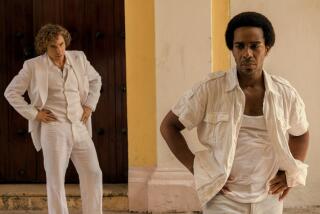‘Wild, Wild Country’ documents bizarre tale of sex, drugs and religious fervor
“Wild Wild Country” tells a tale of sex, drugs, Rolls-Royces, religious fervor, attempted assassinations and bio-terror attacks that would have seemed preposterous on a fictional show. As a documentary series, it struck such a cultural nerve that it even inspired a “Saturday Night Live” skit.
The Netflix series centers on guru Bhagwan Shree Rajneesh, his followers (called Rajneeshees or sannyasins) and their creation of a city in rural Oregon, which raised the ire of the residents of the tiny nearby town of Antelope. The conflict grew to the point where the Rajneeshees armed themselves against perceived religious persecution. The story gets even wilder from there.
The directors, brothers Chapman and Maclain Way, were in Portland finishing up their first documentary, “The Battered Bastards of Baseball,” when an archivist at the Oregon Historical Society offered them 300 hours of footage on these bizarre events they’d never heard of. Once they started watching, they were hooked.
WATCH: Video Q&A’s from this season’s hottest contenders »
Chapman Way: As soon as we started digitizing the footage, the first character that we were absolutely amazed with was Ma Anand Sheela, who was the right-hand spokesperson, and kind of the CEO, of this religious empire. In the footage, she’s the feisty, provocative, foul-mouthed, compelling character who doesn’t take crap from a lot of people and speaks her mind. We instantly knew we wanted to do a longer format series, and we had to hear her perspective of what happened.
How did you convince everyone to participate?
Chapman: When we started reaching out to people on both sides of this issue, they were slightly hesitant in the beginning. Both sides felt pigeonholed and stereotyped over the years. Something that helped Maclain and me was that we were born after this whole entire saga happened, we didn’t live in Oregon and we weren’t part of the sannyasin movement, so we really had no dog in the fight other than to give these people platforms to share their truth and their journey.
There isn’t really a good and bad side in the way the story is presented. Did you go in with the angle not to have an angle?
Chapman: We didn’t feel that we needed to spoon-feed the audience with notions of who’s right, who’s wrong, what’s good, what’s evil. We were obviously confident that people would understand that the criminal actions that the leadership undertook were wrong and horrific, but we were more interested in exploring how the group got to that moment. What’s really interesting is when you listen to Sheela and [her confidante, Jane Stork] and hear their perspectives, you see how far this group is willing to go to protect their community. That’s where these notions of evil get very blurry and it becomes much more of a gray area. People seem to enjoy dwelling in that area.
Maclain Way: I don’t think we would have done this story if we had to do it as a feature documentary. In a feature, the story, no matter what, would get simplified into one side being right and one wrong. With a bigger canvas, it was really exciting to play with those notions of right and wrong.
We found almost everyone we spoke with to be these multidimensional, fascinating characters who had faults and strengths of their own. As filmmakers, we would have hours-long discussions about who was right and who was wrong, and our own positions would constantly change and evolve. There are at least two sides, maybe three or four, that are completely entrenched and against one another. As a viewer coming to the story, maybe at one point or another you’re going to lean on someone’s perspective, or start listening to someone’s version of this event, and start believing that person a little bit more than the others, but then maybe 10, 15 minutes later in the series, you’re hearing new information, and then hopefully you’re questioning that position you took.
What did you think of the cultural conversation the series has engendered?
Chapman: We knew we were making this niche, sociopolitical thriller that took place in eastern Oregon in the ’80s, so our expectations weren’t too high in terms of how many people were going to be watching this or how it was going to be received. So it was surprising for us. Early on, we could tell, from the social media reactions, how much people were diving into the story; a lot of people would live tweet their responses while watching it. It was really interesting to see them critically engage with the story and enjoy that process.
Maclain: It was one of those stories where you might end up with as many good questions as you did good answers. As people who researched the story and got to know a lot of different people on very different sides, we felt that way too — we had a lot of good questions at the end.
More to Read
From the Oscars to the Emmys.
Get the Envelope newsletter for exclusive awards season coverage, behind-the-scenes stories from the Envelope podcast and columnist Glenn Whipp’s must-read analysis.
You may occasionally receive promotional content from the Los Angeles Times.










